Chong Deng
MinMo: A Multimodal Large Language Model for Seamless Voice Interaction
Jan 10, 2025



Abstract:Recent advancements in large language models (LLMs) and multimodal speech-text models have laid the groundwork for seamless voice interactions, enabling real-time, natural, and human-like conversations. Previous models for voice interactions are categorized as native and aligned. Native models integrate speech and text processing in one framework but struggle with issues like differing sequence lengths and insufficient pre-training. Aligned models maintain text LLM capabilities but are often limited by small datasets and a narrow focus on speech tasks. In this work, we introduce MinMo, a Multimodal Large Language Model with approximately 8B parameters for seamless voice interaction. We address the main limitations of prior aligned multimodal models. We train MinMo through multiple stages of speech-to-text alignment, text-to-speech alignment, speech-to-speech alignment, and duplex interaction alignment, on 1.4 million hours of diverse speech data and a broad range of speech tasks. After the multi-stage training, MinMo achieves state-of-the-art performance across various benchmarks for voice comprehension and generation while maintaining the capabilities of text LLMs, and also facilitates full-duplex conversation, that is, simultaneous two-way communication between the user and the system. Moreover, we propose a novel and simple voice decoder that outperforms prior models in voice generation. The enhanced instruction-following capabilities of MinMo supports controlling speech generation based on user instructions, with various nuances including emotions, dialects, and speaking rates, and mimicking specific voices. For MinMo, the speech-to-text latency is approximately 100ms, full-duplex latency is approximately 600ms in theory and 800ms in practice. The MinMo project web page is https://funaudiollm.github.io/minmo, and the code and models will be released soon.
CosyVoice 2: Scalable Streaming Speech Synthesis with Large Language Models
Dec 13, 2024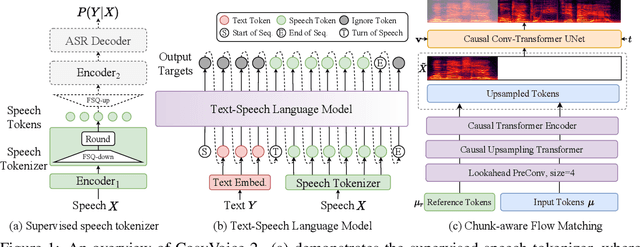

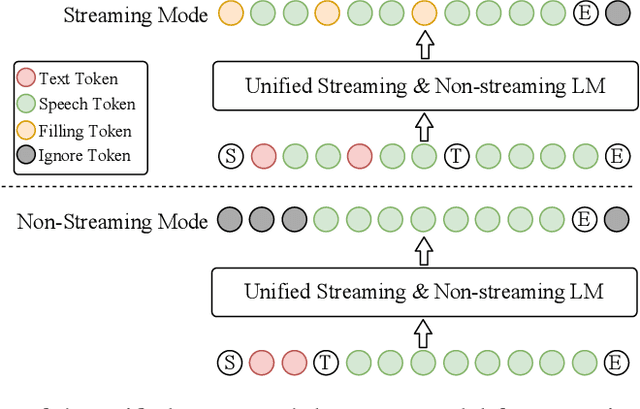

Abstract:In our previous work, we introduced CosyVoice, a multilingual speech synthesis model based on supervised discrete speech tokens. By employing progressive semantic decoding with two popular generative models, language models (LMs) and Flow Matching, CosyVoice demonstrated high prosody naturalness, content consistency, and speaker similarity in speech in-context learning. Recently, significant progress has been made in multi-modal large language models (LLMs), where the response latency and real-time factor of speech synthesis play a crucial role in the interactive experience. Therefore, in this report, we present an improved streaming speech synthesis model, CosyVoice 2, which incorporates comprehensive and systematic optimizations. Specifically, we introduce finite-scalar quantization to improve the codebook utilization of speech tokens. For the text-speech LM, we streamline the model architecture to allow direct use of a pre-trained LLM as the backbone. In addition, we develop a chunk-aware causal flow matching model to support various synthesis scenarios, enabling both streaming and non-streaming synthesis within a single model. By training on a large-scale multilingual dataset, CosyVoice 2 achieves human-parity naturalness, minimal response latency, and virtually lossless synthesis quality in the streaming mode. We invite readers to listen to the demos at https://funaudiollm.github.io/cosyvoice2.
OmniFlatten: An End-to-end GPT Model for Seamless Voice Conversation
Oct 23, 2024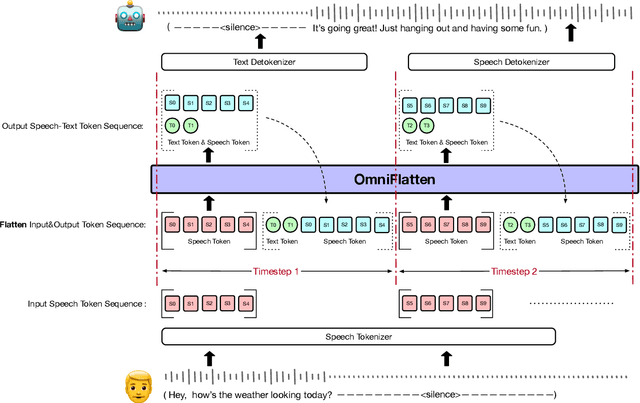
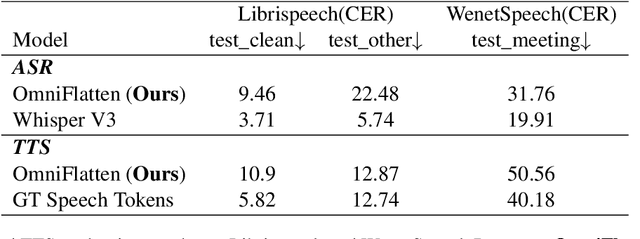


Abstract:Full-duplex spoken dialogue systems significantly advance over traditional turn-based dialogue systems, as they allow simultaneous bidirectional communication, closely mirroring human-human interactions. However, achieving low latency and natural interactions in full-duplex dialogue systems remains a significant challenge, especially considering human conversation dynamics such as interruptions, backchannels, and overlapping speech. In this paper, we introduce a novel End-to-End GPT-based model OmniFlatten for full-duplex conversation, capable of effectively modeling the complex behaviors inherent to natural conversations with low latency. To achieve full-duplex communication capabilities, we propose a multi-stage post-training scheme that progressively adapts a text-based large language model (LLM) backbone into a speech-text dialogue LLM, capable of generating text and speech in real time, without modifying the architecture of the backbone LLM. The training process comprises three stages: modality alignment, half-duplex dialogue learning, and full-duplex dialogue learning. Throughout all training stages, we standardize the data using a flattening operation, which allows us to unify the training methods and the model architecture across different modalities and tasks. Our approach offers a straightforward modeling technique and a promising research direction for developing efficient and natural end-to-end full-duplex spoken dialogue systems. Audio samples of dialogues generated by OmniFlatten can be found at this web site (https://omniflatten.github.io/).
Recording for Eyes, Not Echoing to Ears: Contextualized Spoken-to-Written Conversion of ASR Transcripts
Aug 19, 2024Abstract:Automatic Speech Recognition (ASR) transcripts exhibit recognition errors and various spoken language phenomena such as disfluencies, ungrammatical sentences, and incomplete sentences, hence suffering from poor readability. To improve readability, we propose a Contextualized Spoken-to-Written conversion (CoS2W) task to address ASR and grammar errors and also transfer the informal text into the formal style with content preserved, utilizing contexts and auxiliary information. This task naturally matches the in-context learning capabilities of Large Language Models (LLMs). To facilitate comprehensive comparisons of various LLMs, we construct a document-level Spoken-to-Written conversion of ASR Transcripts Benchmark (SWAB) dataset. Using SWAB, we study the impact of different granularity levels on the CoS2W performance, and propose methods to exploit contexts and auxiliary information to enhance the outputs. Experimental results reveal that LLMs have the potential to excel in the CoS2W task, particularly in grammaticality and formality, our methods achieve effective understanding of contexts and auxiliary information by LLMs. We further investigate the effectiveness of using LLMs as evaluators and find that LLM evaluators show strong correlations with human evaluations on rankings of faithfulness and formality, which validates the reliability of LLM evaluators for the CoS2W task.
Multimodal Fusion and Coherence Modeling for Video Topic Segmentation
Aug 01, 2024Abstract:The video topic segmentation (VTS) task segments videos into intelligible, non-overlapping topics, facilitating efficient comprehension of video content and quick access to specific content. VTS is also critical to various downstream video understanding tasks. Traditional VTS methods using shallow features or unsupervised approaches struggle to accurately discern the nuances of topical transitions. Recently, supervised approaches have achieved superior performance on video action or scene segmentation over unsupervised approaches. In this work, we improve supervised VTS by thoroughly exploring multimodal fusion and multimodal coherence modeling. Specifically, (1) we enhance multimodal fusion by exploring different architectures using cross-attention and mixture of experts. (2) To generally strengthen multimodality alignment and fusion, we pre-train and fine-tune the model with multimodal contrastive learning. (3) We propose a new pre-training task tailored for the VTS task, and a novel fine-tuning task for enhancing multimodal coherence modeling for VTS. We evaluate the proposed approaches on educational videos, in the form of lectures, due to the vital role of topic segmentation of educational videos in boosting learning experiences. Additionally, we introduce a large-scale Chinese lecture video dataset to augment the existing English corpus, promoting further research in VTS. Experiments on both English and Chinese lecture datasets demonstrate that our model achieves superior VTS performance compared to competitive unsupervised and supervised baselines.
Skip-Layer Attention: Bridging Abstract and Detailed Dependencies in Transformers
Jun 17, 2024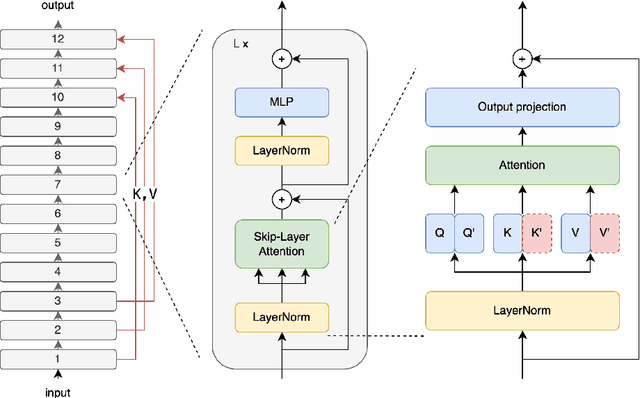
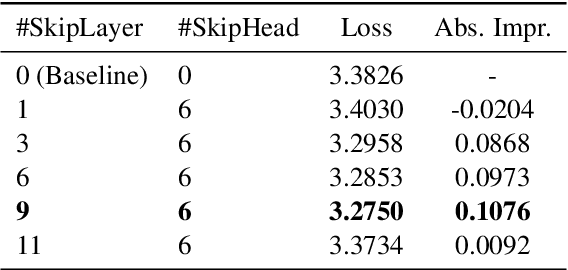


Abstract:The Transformer architecture has significantly advanced deep learning, particularly in natural language processing, by effectively managing long-range dependencies. However, as the demand for understanding complex relationships grows, refining the Transformer's architecture becomes critical. This paper introduces Skip-Layer Attention (SLA) to enhance Transformer models by enabling direct attention between non-adjacent layers. This method improves the model's ability to capture dependencies between high-level abstract features and low-level details. By facilitating direct attention between these diverse feature levels, our approach overcomes the limitations of current Transformers, which often rely on suboptimal intra-layer attention. Our implementation extends the Transformer's functionality by enabling queries in a given layer to interact with keys and values from both the current layer and one preceding layer, thus enhancing the diversity of multi-head attention without additional computational burden. Extensive experiments demonstrate that our enhanced Transformer model achieves superior performance in language modeling tasks, highlighting the effectiveness of our skip-layer attention mechanism.
Loss Masking Is Not Needed in Decoder-only Transformer for Discrete-token Based ASR
Nov 08, 2023



Abstract:Recently, unified speech-text models, such as SpeechGPT, VioLA, and AudioPaLM, have achieved remarkable performance on speech tasks. These models convert continuous speech signals into discrete tokens (speech discretization) and merge text and speech tokens into a shared vocabulary. Then they train a single decoder-only Transformer on a mixture of speech tasks. Specifically, all these models utilize Loss Masking on the input speech tokens for the ASR task, which means that these models do not explicitly model the dependency between the speech tokens. In this paper, we attempt to model the sequence of speech tokens in an autoregressive manner like text. However, we find that applying the conventional cross-entropy loss on input speech tokens does not consistently improve the ASR performance over Loss Masking. Therefore, we propose a novel approach denoted Smoothed Label Distillation (SLD), which introduces a KL divergence loss with smoothed labels on the input speech tokens to effectively model speech tokens. Experiments demonstrate that our SLD approach alleviates the limitations of the cross-entropy loss and consistently outperforms Loss Masking for decoder-only Transformer based ASR using different speech discretization methods.
Improving Long Document Topic Segmentation Models With Enhanced Coherence Modeling
Oct 23, 2023Abstract:Topic segmentation is critical for obtaining structured documents and improving downstream tasks such as information retrieval. Due to its ability of automatically exploring clues of topic shift from abundant labeled data, recent supervised neural models have greatly promoted the development of long document topic segmentation, but leaving the deeper relationship between coherence and topic segmentation underexplored. Therefore, this paper enhances the ability of supervised models to capture coherence from both logical structure and semantic similarity perspectives to further improve the topic segmentation performance, proposing Topic-aware Sentence Structure Prediction (TSSP) and Contrastive Semantic Similarity Learning (CSSL). Specifically, the TSSP task is proposed to force the model to comprehend structural information by learning the original relations between adjacent sentences in a disarrayed document, which is constructed by jointly disrupting the original document at topic and sentence levels. Moreover, we utilize inter- and intra-topic information to construct contrastive samples and design the CSSL objective to ensure that the sentences representations in the same topic have higher similarity, while those in different topics are less similar. Extensive experiments show that the Longformer with our approach significantly outperforms old state-of-the-art (SOTA) methods. Our approach improve $F_1$ of old SOTA by 3.42 (73.74 -> 77.16) and reduces $P_k$ by 1.11 points (15.0 -> 13.89) on WIKI-727K and achieves an average relative reduction of 4.3% on $P_k$ on WikiSection. The average relative $P_k$ drop of 8.38% on two out-of-domain datasets also demonstrates the robustness of our approach.
Improving BERT with Hybrid Pooling Network and Drop Mask
Jul 14, 2023



Abstract:Transformer-based pre-trained language models, such as BERT, achieve great success in various natural language understanding tasks. Prior research found that BERT captures a rich hierarchy of linguistic information at different layers. However, the vanilla BERT uses the same self-attention mechanism for each layer to model the different contextual features. In this paper, we propose a HybridBERT model which combines self-attention and pooling networks to encode different contextual features in each layer. Additionally, we propose a simple DropMask method to address the mismatch between pre-training and fine-tuning caused by excessive use of special mask tokens during Masked Language Modeling pre-training. Experiments show that HybridBERT outperforms BERT in pre-training with lower loss, faster training speed (8% relative), lower memory cost (13% relative), and also in transfer learning with 1.5% relative higher accuracies on downstream tasks. Additionally, DropMask improves accuracies of BERT on downstream tasks across various masking rates.
Ditto: A Simple and Efficient Approach to Improve Sentence Embeddings
May 18, 2023



Abstract:Prior studies diagnose the anisotropy problem in sentence representations from pre-trained language models, e.g., BERT, without fine-tuning. Our analysis reveals that the sentence embeddings from BERT suffer from a bias towards uninformative words, limiting the performance in semantic textual similarity (STS) tasks. To address this bias, we propose a simple and efficient unsupervised approach, Diagonal Attention Pooling (Ditto), which weights words with model-based importance estimations and computes the weighted average of word representations from pre-trained models as sentence embeddings. Ditto can be easily applied to any pre-trained language model as a postprocessing operation. Compared to prior sentence embedding approaches, Ditto does not add parameters nor requires any learning. Empirical evaluations demonstrate that our proposed Ditto can alleviate the anisotropy problem and improve various pre-trained models on STS tasks.
 Add to Chrome
Add to Chrome Add to Firefox
Add to Firefox Add to Edge
Add to Edge